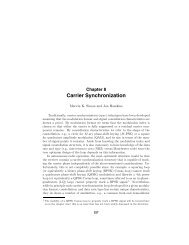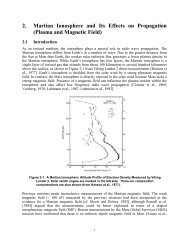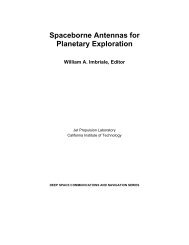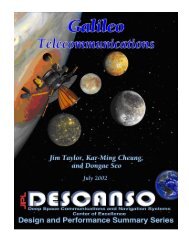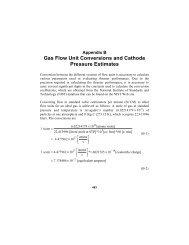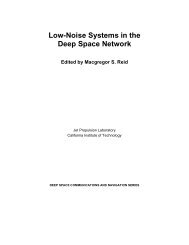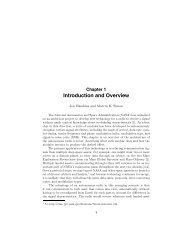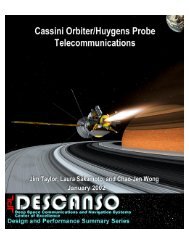Propagation Effects Handbook for Satellite Systems - DESCANSO ...
Propagation Effects Handbook for Satellite Systems - DESCANSO ...
Propagation Effects Handbook for Satellite Systems - DESCANSO ...
Create successful ePaper yourself
Turn your PDF publications into a flip-book with our unique Google optimized e-Paper software.
Plots of noise temperature and attenuation statistics, both<br />
full-year and quarter-year, are available <strong>for</strong> the 15 regions at 15<br />
frequencies (8.5, 10, 12, 15, 18, 20, 25, 28, 30, 32, 35, 39, 44, 49<br />
and 90 GHz). Interested persons should contact Stephen Slobin, Jet<br />
Propulsion Laboratory, Pasadena, CA 91109.<br />
6.4.3 ~<br />
6.4.3.1 Water Content of Foq. Fog results from the condensation of<br />
atmospheric water vapor into water droplets that remain suspended in<br />
air. Fog is characterized by optical visibility, which is defined<br />
- as the distance over which a black target against the sky horizon<br />
background can just be discerned by the human eye. The<br />
international definition of fog is satisfied when visibility is less<br />
than one kilometer (Koester and Kosowsky-1970).<br />
There are two main types of fog, differing in the locale and<br />
method of <strong>for</strong>mation. Advection foq is coastal fog that <strong>for</strong>ms when<br />
warml moist air moves over colder water. The liquid water content<br />
of advection fog does not normally exceed 0.4 g/m3. Radiation fog<br />
<strong>for</strong>ms inland at night, usually in valleys and low marshes, and along<br />
rivers. Radiation fog can have a liquid water content up to 1 g/m3.<br />
Empirical relations have been found (Koester and Kosowsky-1970)<br />
between the liquid water content,pt, and the visibility, V(km):<br />
pt = (18.35 V)-1.43 <strong>for</strong> advection fog (6.4-2)<br />
pc = (42.0 V)-1.54 <strong>for</strong> radiation fog (6.4-3)<br />
6.4.3.2 Attenuation of Foq. The specific attenuation of fog (in<br />
dB/km) is estimated using the curves in Figure 6.4-1. The 10°C curve<br />
is recommended <strong>for</strong> the summer, and the O°C curve should be used <strong>for</strong><br />
other seasons. Typical liquid water content values <strong>for</strong> both types<br />
of fog vary between about 0.1 and 0.2 g/m3. The specific attenuation<br />
of this, assuming a temperature of 10°, would be about 0.08 to 0.16<br />
dB/km at 35 GHz, or 0.45 to 0.9 dB/km at 95 GHz. (See Figure 6.4-<br />
1.) In a typical fog layer 50 m thick, a path at a 30° elevation<br />
angle would be in the fog only 100 m, producing less than 0.1 dB of<br />
6-71





